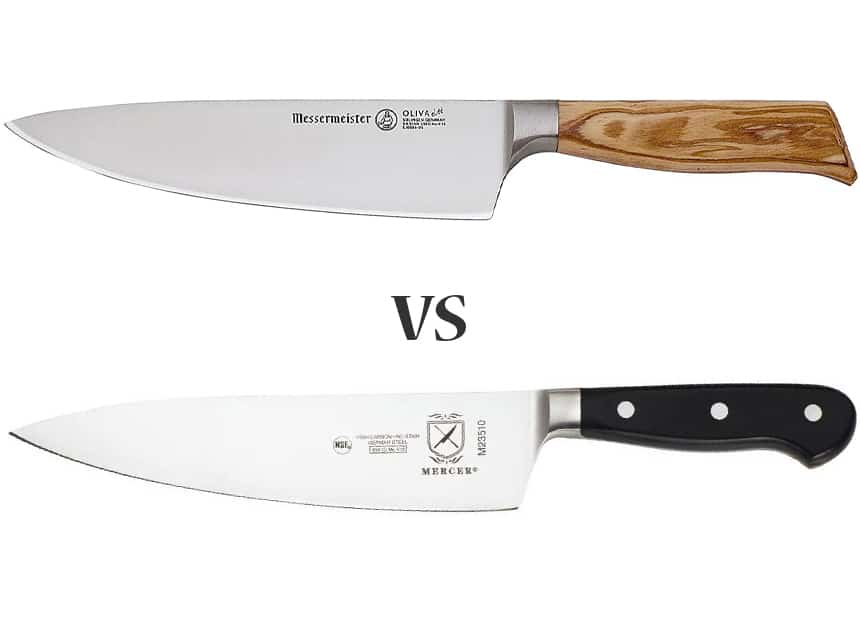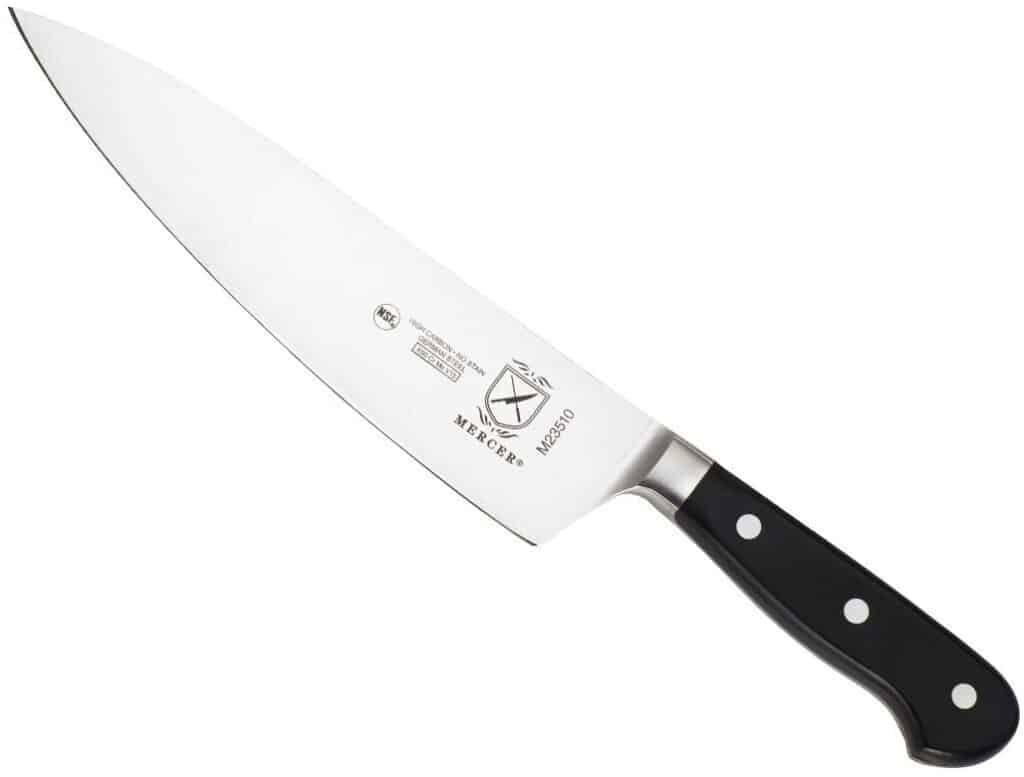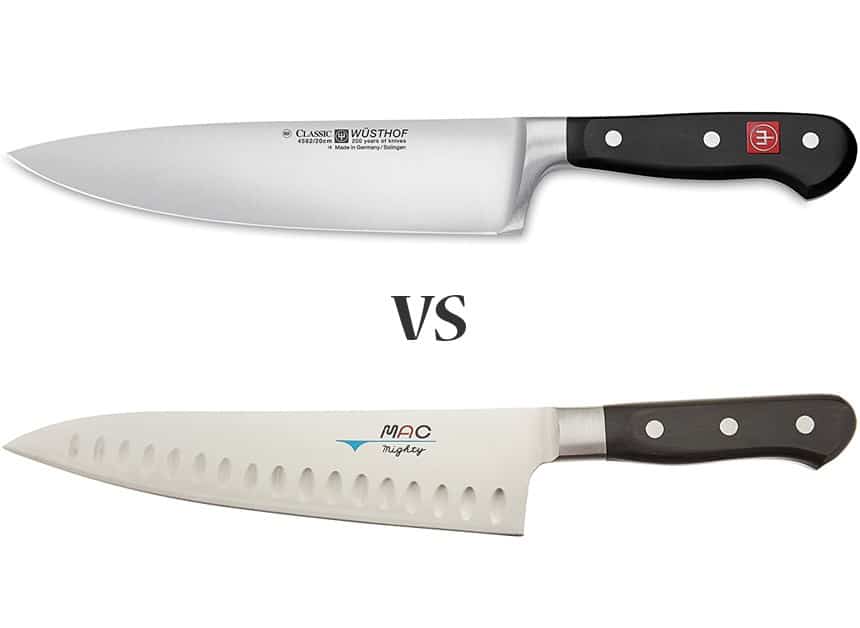
Kitchen knives come in a wide range of different prices, depending on the type of knife, materials used and the brand.
Two brands that rest on very different ends of the price scale are Messermeister and Mercer.
In this article, I’m going to tell you the differences between these two brands.
I’ll go in-depth into the details of each, talking about where they are made, what materials are used and the difference in price.
This article should provide all the information you need to select the right knife for your needs.
If you ignore the price and focus on quality, Messermeister knives are unarguably better. They are built for extreme durability and use both classic and beautiful designs. Mercer’s Renaissance range does offer an experience close to that of a Messermeister, but their Taiwan manufactured knives cost significantly less.
| My recommendation | Current price |
| Messermeister Oliva Elite 8-Inch | View on Amazon (opens new tab) |
| Mercer Culinary Renaissance 8-Inch | View on Amazon (opens new tab) |
Messermeister vs Mercer – Comparison Table
Here is my summary comparison table for each brand. This is mostly based on their most popular knives; the Messermeister Meridian Elite and the Mercer Renaissance Chef’s Knife.
For a more in-depth look at each category then check out the rest of the article below.
| Category | Messermeister | Mercer |
| Country of Manufacture | Germany | Taiwan |
| Steel type | X50CrMoV15 (1.4116) | X50CrMoV15 |
| Rockwell hardness | HRC 57 | HRC 56-58 |
| Factory edge | 15 degrees (double bevel) | 15 degrees (double bevel) |
| Handle material | POM (thermoplastic) | POM (thermoplastic) |
| Price range | $150 – $170 (Meridian Elite) | $50 – $60 (Renaissance) |
| Main benefit | More durable, higher quality, stylish | Low price, well designed |
| My recommendation | Messermeister 8-Inch Meridian Elite (view on Amazon) | Mercer Renaissance Chef’s Knife 8-Inch (View on Amazon) |
Messermeister vs Mercer – Where are they made
| Brand | Country of manufacture |
| Messermeister | Germany |
| Mercer | Taiwan |
Messermeister Knives are produced in the German city of Solingen, where they have been produced since their launch in 1985.
Messermeister is German for Knife (Messer) Maser (Meister), they have always had a focus on innovative design whilst still being influenced by German classics.
Bernd Dressler, the founder of Messermeister was the first western knife maker to introduce a bolsterless heel to his knife range, a trend that is found throughout western knives today.
Mercer manufactures their knives in Taiwan, using imported German steel.
Mercer is part of a growing trend in the knife industry of using quality materials, like German or Japanese steel, but basing the manufacture in low cost countries, like China or, in Mercer’s case, Taiwan.
In the past these less authentic brands have been of noticeably lower quality, but more and more these brands are actually producing knives of a comparable standard to their German or Japanese counterparts, for a much lower price.
Messermeister is clearly ‘the real deal’ in regard to being a truly German manufacturer of German style kitchen knives, whereas Mercer is a less authentic brand without nearly the same level of heritage.
Messermeister vs Mercer – What steel do they use
The first thing to know is that Messermeister and Mercer actually both use the same steel for their knives, at least in their main range.
| Brand | Steel type | Rockwell hardness |
| Messermeister Meridian Elite | X50CrMoV15 | HRC 57 |
| Mercer Renaissance | X50CrMoV15 | HRC 56-58 |
Both these knives use the same steel, X50CrMoV15. Messermeister provides a very accurate HRC rating for their steel at 57 whilst Mercer states a range of 56-58, which is pretty typical for X50CrMoV15.
Both the Messermeister Meridian Elite and Mercer Renaissance are made from forged steel so you’ll find hardly any difference between the two in terms of sharpness and performance.
Both Messermeister and Mercer use X50CrMoV15. It’s a German steel that is popular amongst producers of quality western-style knives, mainly due to its durability.
X50CrMoV15’s large benefit is its durability, and that’s why it’s so popular with many European knife brands.
The main elements of interest within X50CrMoV15’s composition are Carbon, Vanadium and Chromium.
The Carbon content is around 0.55%. That’s not particularly high when comparing it with other quality knives; however, it’s high enough to provide sufficient strength in the blade for a 15 – 20 degree angle on each side, which is standard for western knives.
The big benefit of not having a very high Carbon content is that higher Carbon steels are usually more brittle, therefore the 0.55% content keeps the blade durable.
That’s the same with the strong Vanadium of 0.4%, Vanadium improves the resistance to wear of the steel also adding to its durability.
The Chromium content is 15% is what the 15 in X50CrMoV15 represents. Chromium is vital for the durability of steel as it’s what makes stainless steel resistant to rust.
Steel need only be 10.5% to be considered stainless, so a 15% content is high and makes this a quality stainless steel, very unlikely to rust unless extremely mistreated by the owner.
Ultimately, on the cutting edge, both of these knives will perform almost exactly the same.
Messermeister vs Mercer – How sharp are they
Once again I’m going to focus on the most popular knives from each brand for this comparison. That’s the Messermeister Meridian Elite and Mercer Renaissance.
You will experience an almost identical sharpness between the Messermeister and Mercer knives and both will hold their edge for a similar length of time.
| Brand | Factory edge | Rockwell hardness |
| Messermeister Meridian Elite | 15 degrees (double bevel) | HRC 57 |
| Mercer Renaissance | 15 degrees (double bevel) | HRC 56-58 |
Both Messermeister and Mercer use the same steel for their main range, as such there will be very little difference between the two when it comes to sharpness.
The two steel are ultimately going to be extremely similar and will perform almost exactly the same for sharpness.
There isn’t much to choose between the two when measuring sharpness.
Messermeister vs Mercer – What are the handles made from
The material used for handles is a vital and often overlooked feature of any knife.
A quality handle is often the sign of a quality overall knife. Handles need to be made from a durable material that can withstand all the heat and moisture fluctuations knives can experience in the kitchen.
Once again we’ll focus on the two main ranges from each brand, the Messermeister Meridian Elite and Mercer Renaissance.
| Brand | Handle material |
| Messermeister Meridian Elite | POM (thermoplastic) – Although other Messermeister ranges use stunning timber for the handle |
| Mercer Renaissance | POM (thermoplastic) |
Both the Messermeister Meridian Elite and Mercer Renaissance use a thermoplastic material called POM (Polyoxymethylene) for their knife handles.
Although, it is worth mentioning that Messermeister use some very attractive timbers for their other ranges such as Royale Elite (American Walnut) and Oliva Elite (Olive Wood) that are exquisitely beautiful and perhaps one of the defining differences between the two brands.
It is also worth mentioning that the lower price ranges of Mercer, such as the Genesis rane, use a Santoprene handle. This is a thermoplastic elastomer (TPE), which is still very durable but not as hard as POM, the advantage is increased grip due to the texture, but it is more prone to damage.
But for now, let’s focus on POM as that is used by both brands in their main range. Materials like these are ideal for knife handles due to their extreme durability.
POM is specifically designed for high stiffness and stability, and being a thermoplastic means it’s also extremely resistant to temperature and moisture changes.
It’s a fantastic material to use for knife handles, that will undergo all sorts of pressures.
Messermeister vs Mercer – How much do they cost
Both these brands have wide ranges of knives all at differing price ranges.
To allow for a fairer comparison I’ve categorized three of their major ranges that represent their highest and lowest cost knives.
I’ve tried to compare similar knives, sticking to 8 Inch Chef’s knives or the closest equivalent they have in the range.
In brackets next to the general price range you’ll see the name of the range.
These prices are rough estimates. Prices do change over time but this is intended as a rough guide.
| Brand range | Messermeister | Mercer |
| Premium | $170 – $190 (Oliva Elite) | Not Applicable |
| Standard | $150 – $170 (Meridian Elite) | $50 – $60 (Renaissance) |
| Value | $35 – $45 (Four Seasons) | $15 – $25 (Millennia) |
This is easily the main benefit of Mercer knives over Messermeister.
Mercer knives are significantly less expensive. In fact, you could pretty much consider all of the Mercer ranges to be value ranges, and they don’t offer any knives close to a Premium price.
I have to say, Mercer does offer a very good product for the price. The very low Millennia range is not going to be as durable as a Messermeister knife, but for the price you would expect it to.
But when you look at the Mercer Renaissance range, as most of this article does, what you get is a knies that is very similar to the Messermeister Meridian Elite but is around one third of the price.
Is it a genuine German knife? No, it’s made in Taiwan using imported German steel, and that’s the main reason it is so much less expensive.
But it does use the exact same steel Messermeister use, and the entire design and build quality is similar.
If price wasn’t a factor, Messermeister would always be my first choice between these two because they make some of the best quality western-style knives in the world, but for those on a budget Mercer offers serious value for money.
Messermeister vs Mercer – What is the difference
Now that we have looked at the design, materials, background and price of these brands we can fully understand the difference, and you should be able to make an informed decision on which knife is correct for you.
The main difference between Messermeister and Mercer knives is the price. Mercer knives generally cost much less than Messermeister. However, Messermeister offers knives for far better quality and does justify the price difference.
| Brand | Main benefits |
| Messermeister | More durable, higher quality, stylish |
| Mercer | Low price, comfortable design |
I like both these brands, but there is a clear difference in the average price and that’s because they are just not equal in terms of quality.
Messermeister is a name that’s synonymous with quality and durability. Their knives use classic and beautiful designs and are built to last.
Mercer has focused on the more budget-friendly end of the price scale, and they actually offer incredible value for money.
The really cheap Mercer knives, at the $20 mark, are not comparable to the quality a Messermeister would offer, although they are still a good option if you’re on a very tight budget.
But the Mercer Renaissance, is a good contender against the Messermeister Meridian Elite, using pretty identical materials and having a very similar design.
Messermeister vs Mercer – Which is better for you
The determining factor for which of these brands you choose really comes down to budget.
If you have over $100 to spend, I definitely recommend a knife from Messermeister over Mercer. I think Messermeister offers some of the best western-style Chef’s knives within the $100 – $200 price range.
However; if you have under $100 to spend then Mercer is certainly worth a consideration.
Mercer are fantastic at making quality knives that are still budget friendly and use the exact same X50CrMoV15 steel as high end western knives.
If you are on a tight budget, Mercer is a strong contender for the best brand around $50.
My Messermeister Recommendation

View the 8-Inch Messermeister Oliva Elite on Amazon (opens new tab)
For my Messermeister recommendation I’ve gone with one from their premium collection, especially the Oliva Elite collection.
This knife is stunning. I think it’s the most attractive western style Chef’s knife available.
The Olive Wood handle gives it such a beautiful finish that it really stands out from other knives.
Olive wood won’t be quite as durable as other thermoplastic handles, so you will have to avoid doing things like soaking it in the kitchen sink, because that’s clearly going to warp the wood over time.
But as timber goes, Olive wood is still a good material for knife handles, it’s hard and strong so it will be durable, it’s just hard to match the artificially created durability of substances like POM with natural materials.
It’s a great knife, so if you want to add a bit of beauty to your kitchen then there are few better choices than this Messermeister Oliva Elite.
My Mercer Recommendation

View the 8-Inch Mercer Renaissance Chef’s Knife on Amazon (opens new tab)
This is one of the most expensive knives from Mercer, and it’s still only at the price of most other brands value ranges!
What you get for around $50 is very good value. X50CrMoV15 forged german steel, half bolster with a thermoplastic, triple riveted handle and a classic western chef’s knife design.
It’s a knife you just can;t be disappointed with at that price.
It may not be the genuine article in that it’s manufactured in Taiwan instead of German, but it’s still a quality knife, and an absolute bargain.

